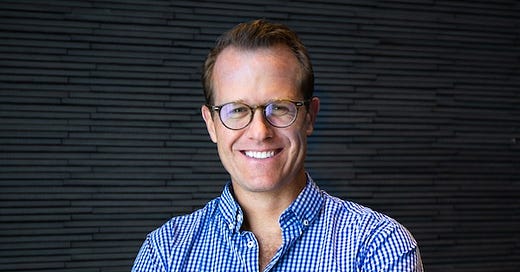Burford Capital helps companies and law firms unlock the value of their legal assets. With a $7.2 billion portfolio and listings on the NYSE and LSE, Burford provides capital to finance high-value commercial litigation and arbitration—without adding cost or risk or giving up control. Clients include Fortune 500 companies and Am Law 100 firms, who turn to Burford to pursue strong claims, manage legal costs, and accelerate recoveries. Learn more at burfordcapital.com.
“I had no idea how much sales work would be involved before I took this job,” a friend who’s now in a leadership role in his law firm told me. A former trial lawyer used to passing hours on end in courtrooms, he now spends about 70 percent of his time on business development and management—and only 30 percent on practicing law.
And he’s not alone. A law school classmate who’s now a practice-area leader at an Am Law 100 firm said that as he has risen higher at the firm, he’s had to spend more time on sales—to the point where he’s starting to miss the good old-fashioned practice of law, representing clients “in the trenches.”
How can law firm partners get better at business development, given how important it’s become to their work? That’s the subject of The Activator Advantage: What Today’s Rainmakers Do Differently, published by the Harvard Business Review Press. Orrick chairman Mitch Zuklie described the book as “groundbreaking for our rising stars, helping them understand what our most successful partners do.”
Last month, I interviewed Dr. Matthew Dixon, the book’s lead author and a co-founder of DCM Insights, a growth consultancy for professional-services firms. Although not a lawyer by training (he holds a Ph.D. in political economy), Dixon has spent countless hours with lawyers over the years, advising them and other providers of professional services on how to excel at business development.
[Ed. note: I’ve released my full interview with Dr. Dixon as a bonus episode of the OJ podcast, which you can listen to by clicking on the embed at the top of this post or through Apple Podcasts, Spotify, or your podcast platform of choice.]
Top partners need to focus more than ever on selling. Why? The markets for professional services, including but not limited to the market for legal services, are more competitive than ever. As the chief marketing officer of one Am Law 100 firm told Dixon, “Clients today are a lot less loyal than they used to be.”
To write The Activator Advantage, Dixon and his co-authors conducted what they called the “Rainmaker Genome Project.” They surveyed almost 3,000 individuals at more than 40 professional-services firms—with lawyers, at 39 percent of respondents, constituting the largest cohort in the study—to understand their approaches to business development. This research revealed the profiles of five different types of professionals: Experts, Confidants, Debaters, Realists, and Activators.
The Expert is “the reluctant business developer—far more comfortable doing the work than selling the work.” Experts believe their expertise should speak for itself—and that clients should hire them based on that deep subject-matter knowledge, without the partners having to go out and pitch for the work.
The Confidant is “an old-school trusted adviser,” someone who tends “to focus on a small handful of clients and predicate their business development approach on being extremely client-centric.” This is the most common profile among lawyers, who pride themselves on being dedicated to their clients.
The Debater might be uncharitably described by colleagues as “sharp-elbowed, opinionated know-it-alls.” The Debater’s approach “is to go in and tell clients they’re thinking about it all the wrong way” or that the conventional wisdom they’re hearing from others is incorrect.
The Realist strives to be “completely transparent about what they can and can’t deliver, what an engagement or matter will cost, and what the client should realistically expect in terms of outcome and value.” Realists cast themselves as giving their clients “the straight scoop,” telling them what they need to hear, not what they want to hear.
Finally, the Activator is a “super-connector,” someone who sees their large professional network as “their most important strategic asset.” Activators engage in proactive outreach to build and maintain robust networks, but they don’t stop there; they find ways to turn these networks into paying client relationships.
Which of these profiles tends to be the most effective in business development? While any of the five can be top rainmakers, “the odds of being a high performer are greatest for professionals who major in the Activator approach,” according to Dixon.
How can aspiring rainmakers become Activators? Dixon highlighted three things that Activators do: “They commit to business development, they connect broadly and deeply, and they create value proactively.”
This all might sound quite obvious. As Dixon put it to me, quoting what one skeptic said to him, “So you’re telling me that the people who developed the most business are the ones who do the most business development?”
But ramping up your business-development efforts is easier said than done, especially if you don’t enjoy selling. So Dixon offered some concrete tips.
First, on committing to business development, “carve out small chunks of time every day, every week, to build that pipeline of opportunities.” He acknowledged that it isn’t realistic for many lawyers to put specific times for business development on their calendars, given the unpredictability of their schedules. Instead, on Sunday night or Monday morning, draw up a list of business-development tasks for the coming week—and go through those items when free time happens to arise.
Second, in terms of connecting broadly and deeply, dive into LinkedIn. Update your profile (including adding a picture), accept and make connections, and send messages or connection invites to every actual or prospective client you’ve met with over the past three months—and do this for clients you connect with from now on.
Once connected, observe what your clients are saying on LinkedIn. Dixon discussed one situation where a consultant learned that a longtime client had hired a boutique for a project that the consultant’s firm could have easily handled. Why? A professional at the boutique saw a LinkedIn post from the client raising a certain issue, reached out with an offer to help, and snagged the engagement before any other provider could even pitch for the work.
Reaching out in response to a client describing a problem was a good example of creating value proactively, the third thing Activators excel at.
“Instead of waiting for the phone to ring, think deeply about what are the things you wish all your clients knew,” Dixon said. “And then reach out to share those insights.”
“When we survey clients, we find that their biggest complaint about professionals, and lawyers in particular, is that the clients don’t hear from them often enough,” Dixon explained. “And lawyers are very surprised by this because they fall into this mindset of, ‘I don’t want to bother my clients. They know how to reach me. They’re busy people.’”
But it’s precisely because clients are so busy that they appreciate lawyers contacting them to flag potential issues.
“Clients tell us, ‘I’m so heads-down at my job, focused on what’s going in within my own organization. The lawyers I work with are going to talk to more clients in a week than I’m going to talk to in a year.’”
“Clients welcome lawyers telling them what’s keeping their other clients up at night,” Dixon said. “Tell them what they don’t know.”
A version of this article originally appeared on Bloomberg Law, part of Bloomberg Industry Group, Inc. (800-372-1033), and is reproduced here with permission.
Thanks for reading Original Jurisdiction, and thanks to my paid subscribers for making this publication possible. Subscribers get (1) access to Judicial Notice, my time-saving weekly roundup of the most notable news in the legal world; (2) additional stories reserved for paid subscribers; (3) transcripts of podcast interviews; and (4) the ability to comment on posts. You can email me at davidlat@substack.com with questions or comments, and you can share this post or subscribe using the buttons below.














Share this post